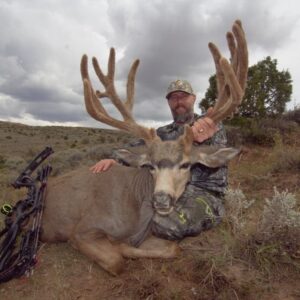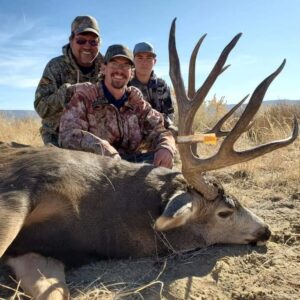Being good at field judging mule deer begins with knowing the basics of scoring a mule deer. Under the Boone and Crockett Club’s scoring system, the gross score for a typical mule deer is the sum total of measurements of his inside spread, length of his main beams, length of points, and eight mass or circumference measurements. By definition, a typical mule deer will have four points per side, plus eye guards.
When you’re out in the field, calculators tend to be in short supply, but there are a few quick things to look for to determine whether a buck is a “shooter”.
Width
Most mule deer hunters get caught up in the outside spread when in reality, the actual measurement taken will be on the inside spread of the main beams. It takes more than just being 30 inches wide to make a truly huge mule deer.
- The easiest method for quickly judging the spread on any mule deer is the distance from ear-tip to ear-tip which is usually very close to 20 inches.
- If a bucks antlers are roughly two inches past the outside of his ears on each side, then he has a 24″ spread.

Tine Length
When field judging mule deer, start towards the bottom and work your way up. One of the most overlooked measurements on any buck is the brow tines, or G-1’s. As a general rule, mule deer have short brow tines compared to whitetails.
- A good buck will usually (but not always) have 4 inch or longer brow tines.
- Next look at the depth of the back forks. If they meet or exceed 12-inches on the G-2.
- Then move to the G-3, or the tine that together with the G-2, forms the back fork. The G-3 should be at least a 6 inches.
- The “backs” are very often the weakest part of a mule deer rack and if they resemble a “crab claw”, then he is probably a young buck. The G-4 is the tine that along with the main beam produce the front fork. As opposed to the back fork, this fork will be much deeper in appearance. G-4’s should be 10+ inches.
- In a nutshell, if a buck has good forks, on both front and back, he is a “shooter” in most hunters’ books.

Mass
Mass has saved the lives of many, many mule deer bucks… when a buck has good mass, his tines look short, and some hunters will let him walk… oops. There really isn’t a lot I can tell you about mass, except don’t overlook it. What a mule deer lacks in tine length, he can make up for in mass.
- When scoring a mule deer buck, you will take four circumference measurements on his main beam, or H measurements.
- The H-1 will be the smallest place between the burr and first point.
- H-2 will be taken at the smallest place between the first and second point.
- H-3 is measured at the smallest place between the main beam and the third point.
- H-4 measurements are from the smallest place between the second and fourth point.
- If a buck has 35 to 40 inches if mass, he is big.

Main Beam
When field judging mule deer, be sure to check all angles before making a decision to shoot or let him walk. Main beam length can be deceiving, especially if the only view you get is head-on. In most instances, if a buck has good width, the main beams should be good as well. Width and main beam measurements usually go hand in hand and these two measurements will usually be within an inch or so of each other.
*Remember width is main beam to main beam. There are bucks out there that will blow this little theory out of the water, but they are the exception to the rule… with them you will just have to guess.

Symmetry
One of the most difficult aspects of field judging mule deer is symmetry, or the scoring balance between the two sides of a bucks rack. It is quite easy to judge the symmetry of tine length, but main beam, can be very difficult to judge because it swoops to the rear and then juts forward and can trick the eye. While many bucks first appear to have unbalanced antlers, when scored are quite symmetrical.

Velvet vs. Hard Antler
Velvet makes average antlers look big and big antlers look enormous, it’s that simple. Accurately field judging mule deer at this stage of the season can be tough.

NOTE: Although by no means a confirmed calculation, whenever I’m field judging deer on the hoof, I typically subtract about five percent from what they appear to score to estimate the actual Boone & Crockett score.
Sometimes when your field judging mule deer, no decision is needed at all!

Usually a mule deer takes some evaluation to come up with a true estimation of its trophy quality, but every so often, if you’re lucky you will come across a buck of Boone and Crockett quality that will measure over the all-time book minimum of 190 inches. These are the bucks that require no second glance; you just know… SHOOT!
Whether it is your first mule deer hunt or you’re an old pro, hopefully these tips will help you make a “snap judgment” on your next trophy mule deer.
Most trophy bucks have at least a couple of these characteristics, but very few have all of them. Consider these features as you field score deer on your next outing and you’re well on your way to knocking down a trophy.
BTW, here’s a good guide to booking a mule deer hunt.
Browse our mule deer hunts.
Contact us About This HuntLive Like You Mean It
Contact Us
We've helped thousands of OI clients plan their adventures
Our team of professional consultants are ready to help you research, book and plan an amazing trip with one of our amazing outfitter partners around the world.
I didn't think an experience like this was possible.
This trip, was, for me at least not just a trip, for me it was a real adventure, a real experience. I love the wilderness and this trip afforded me the opportunity to connect with the Alaskan wilderness in ways very few people do. It was an experience I will never forgot in a place I can’t wait to get back to.Oliver Fischer
The outfitter handled everything perfectly.
We were thankful that Outdoors International hooked us up with a great outfitter because they were able to find us an acceptable alternate on short notice. Overall the two year process to get this float in was seamless and worry free. Just like it should be.Thank you, Stan Masneri
What an amazing experience!
The lodge was out of this world! Our rooms, the delicious food, the incredible wildlife and the scenery were amazing. Our photo safari guide was truly exceptional and had us on animals almost constantly. We saw over 30 different species and had some incredible up close experiences. Africa is amazing!Scott Navares
Copyright 2005-2025 © Outdoors International™ · All Rights Reserved.


























nice piece of mule deer info if you are into that sort of thing.
Pingback: Mule Deer judging-- make it interesting - Page 7 - Utah Wildlife Network
Thanks very informative for field judging antler.